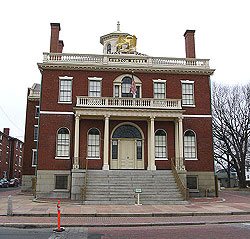The following is a quote from the novel I just started reading, The Scarlet Letter, by Nathaniel Hawthorne:
"In my native town of Salem...stands a spacious edifice of brick."
Notice the ellipsis that I placed in the center of this quote? (My kids call it a "dot-dot-dot".) You never really know how much information is missing when you come across an ellipsis; sometimes it's just a few words. In this case I counted:
127 words
20 commas
20 commas
3 dashes
2 semicolons
Here's everything I took out of the above sentence and replaced with the ellipsis:
...at the head of what, a century ago, in the days of old King Derby, was a bustling wharf -- but which is now burdened with decayed wooden warehouses, and exhibits few or no symptoms of commercial life; except, perhaps, a bark or brig, half-way down its melancholy length, discharging hides; or, nearer at hand, a Nova Scotia schooner, pitching out her cargo of firewood -- at the head, I say, of this dilapidated wharf, which the tide often overflows, and along which, at the base and in the rear of the row of buildings, the track of many languid years is seen in a border of unthrifty grass -- here, with a view from its front windows adown this not very enlivening prospect, and thence across the harbour...Reading a sentence like that is tiring. It takes stamina to get through a whole book full of them; yet as I proceeded through the rather lengthy introduction to the Scarlet Letter, the process of reading and comprehension seemed to become less grueling. A vague notion came over me that I had performed this mental exercise before, only in some other way. It took me a moment to pinpoint. Then suddenly it came to me -- piano lessons.
If it were piano music you would play it like this:
So you read,
In my native town of Salemmmmmmmmmmmmmmmm...
and you hold that thought in your mind while the right hand begins to play a lilting, legato accompaniment:
...at the head of what, a century ago, in the days of old King Derby, was a bustling wharf ...
Blah, blah, blah and so on and so forth -- just keep holding the left hand down. Don't let go of it or you'll have to go back and read it again, because by the time you get to the end you will have forgotten what the sentence is about.
...a Nova Scotia schooner, pitching out her cargo of firewood -- at the head, I say, of this dilapidated wharf, which the tide often overflows...
Hold it... hold it... keep holding; we're nearing the close now, hang in there!
...here, with a view from its front windows adown this not very enlivening prospect, and thence across the harbour,
Now the left hand ends with nine slow, triumphant notes:
stands
a
spa-cious
ed-i-fice
of
brick.

Do you ever use special tricks to help you conquer a difficult passage?



I have a confession to make - I just skimmed the introduction of The Scarlet Letter. I laughed out loud when I read your analogy - I totally understand! ;-) I play the piano as well - it was a perfect choice!
ReplyDeleteI'm glad that made sense to you!
ReplyDeleteYes, the intro. to the Scarlet Letter was tough, but the rest of the novel has turned out to be a page turner.
I'm currently on Chapter 12. I'm probably the only person in the world who doesn't know how it ends.
This is perfect. I think the entire Custom-House could have been summed up with just two or three more. It should have simply read, "In my native town of Salem . . . stands a spacious edifice of brick . . . where I found an embroidered A . . . and wrote this pretend story about it."
ReplyDeleteAlso, this piano analogy is perfect. It maybe speaks a lot about my personality and close connection to Hawthorne. He and I, we might be organists, because on organ you can hold down a pedal tone infinitely and ramble on for ever and ever and ever before finally reaching your point.
Look, I've just now done it. :-)
Oh, and brilliant use of fonts.
I'm done now.
IV - I (A-men.)
Oh yes Christina, the organ metaphor is even better. :)
ReplyDeleteAdriana - I loved this analogy! I think it will make reading these sentences more enjoyable to think of them in a musical vein.
ReplyDeleteJeannette
Excellent comparison. If I ever have to read Hawthorne's intro again, I'll play some background music and think of your post.
ReplyDeleteLove this. So much fun. I read like that a lot, until I'm "hooked". Fun.
ReplyDeleteI SKIPPED the introduction and read the book. Then, I went back and read the introduction, and it was SOOOO much more interesting to me!
ReplyDeleteGгeat blog yοu have got heгe.. It's difficult to find good quality writing like yours these days. I seriously appreciate people like you! Take care!!
ReplyDeleteAlso visit my webpage; payday loans no credit check